The tiny contingent of Sisters of St. Joseph, led by Mother Delphine Fontbonne, rolled up their sleeves and got to work — “work” being the operative word since this is a congregation built on finding and filling the needs of a community ... whatever it took. Entering its 170th year in Toronto, the congregation’s work in Toronto has never stopped, and the tentacles of its work stretches across Canada, indeed the world.
The number of nuns has dwindled of course (79 today), but it is assured the legacy will live on. And in this special year commemorating 170 years, it is a legacy worth celebrating.
The imprint the sisters have made is seen and felt in a variety of institutions they either founded or fostered, from schools to hospitals and ministries that care for our most vulnerable. The story of the first congregation of St. Joseph sisters goes back more than 370 years, to La Puy-en-Velay, France, formed under the spiritual direction of a Jesuit missionary, Jean Pierre Medaille. The mission was simple: serve your neighbour.
That’s a pretty broad mandate, but gave the sisters the freedom to dive into a variety of fields, the most pressing of those being education and health care. That need has never waned, nor the commitment, with the congregation active in more than 50 countries.
The Canadian story starts with Sr. Delphine, who was born in France and was barely 22 years old when she led a small group of sisters to the United States, establishing communities in St. Louis and Philadelphia. Toronto’s Bishop Armand-François-Marie de Charbonnel managed to secure Fontbonne’s services in 1851, eager to create a stronger presence of religious in his city.
The orphanage was a start, but the sisters rapidly expanded their mission, becoming the de facto builders of social enterprises for the growing yet under-serviced city. Through the 19th, 20th and now 21st centuries, the Sisters of St. Joseph “brand” has been synonymous with a caring community on so many levels — from hospitals to food banks to the youth-oriented Faith Connections — and has spread past Toronto with five other CSJ congregations in Canada.
The story is not without some tragic twists. As Toronto was hit with another epidemic in 1855, two of Mother Fontbonne’s fellow sisters died from typhus, and she herself became a victim, passing away at the age of 43. She had been in Toronto just over four years.
The name lives on, though, as will the spirit of the congregation, born from a pretty simple but powerful mission: “The love of Christ gathers us together to live in communion with all. As a community of women we are sent to serve those in need in simplicity and compassion.”
They deserve our congratulations and heartfelt thanks.


